What is the right table height for you?
It is the table height that allows you to lean effectively to deliver pressure without hurting your body.
You’ll need to experiment to figure out what table height setting works best for you. In a few minutes I’ll give you my recommendations. But first, I have a question for you: What’s your table height set at now?
Twenty-five years ago I was taught that to set my table height, my distal knuckles should touch the top of the table when my arms were at my sides. Look on the Internet and you’ll find a range of table height advice, like: the height of your table should be your height divided by two.
Though well intended, a standardized table height setting should not be your goal standard for setting your table height.
Why?
- Different sizes.
- Different body part requests.
- Different pressure request.
- Different massage styles.
- Different chronic conditions and injuries.
1. Different Sizes
When I say different sizes I’m talking not just talking about massage clients, I’m talking about massage therapists, too. Let’s start with massage therapists.
MTs Come in Different Limb Lengths
Two people at the same height don’t necessarily share the same limb length. Jennifer and Shanice are 64 inches tall. When they stand against the same massage table, Jennifer’s fingertips are 1 inch farther away from the table than Shanice’s.
Imagine Jennifer and Shanice are leaning to apply pressure. Depending on the massage style of Jennifer and Shanice, a 1 inch differential in arm length could make a difference in how high or low each sets her table.
Clients Come in Different Thicknesses
Clients come in all sizes. Ricardo, who weighs 305 lbs, is “thicker” than Jamar who weighs 150. That means if Ricardo and Jamar were lying on a table side-by-side, the top of Ricardo’s body would be an inch or two higher off the table than Jamar’s. If you set your table height at the Jamar level for each massage, you’d be giving up an inch or two of leaning leverage when working on someone big, like Ricardo.
2. Different Body Part Requests
When a client is lying on the table, body parts stick up at varying heights. For instance, glutes will stick up off the table higher than calves. If you’re focusing on glutes and your table height is too high, you won’t be able to generate enough pressure from leaning.
3. Different Pressure Requests
Light pressure is less important in terms of dialing in on table height. A high table can help keep the flexion out of your back and a low table is workable if you know how to use the massage table for support. However, a request for medium or deep pressure should make your ears prick up.
In general, when talking about leaning to generate pressure, medium and deep pressure require you to apply more force. You safely do that by leveraging more of your body weight onto the client and/or driving from your legs. Whether you are more of a using-your-body- weight leaner or a driving-from-your-legs leaner depends on your massage style.
4. Different Massage Styles
Which body part would you pick to work on hamstrings using medium to deep pressure? Are you an elbow/forearm or a fist/knuckles or a palms/fingers massage therapist?
Knowing which body parts you’ll use the most during a massage is a key for setting your table height at the beginning of the massage.
If you’re a forearm/elbow MT you’ll need less leaning leverage than you would if you’re a fist/knuckle MT. So your table will probably be higher.
What about your techniques? Are you more of an ischemic compression/trigger point therapist or gliding/relaxing therapist?
My massage emphasis is ischemic compression/trigger point so I look more like a chiropractor when I massage, meaning I’m taking full advantage of my body weight to generate pressure by working on a low table.
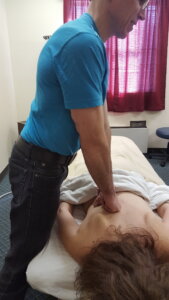
A forearm massage therapist who doesn’t need to be over the table may prefer a higher table to lean into. In a lunge stance she doesn’t need to use all of her body weight to generate force because she can drive from her back leg.
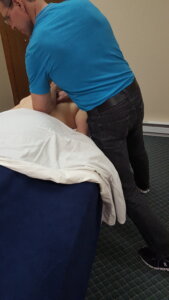
5. Different Chronic Conditions and Injuries
The last thing you’ll need to consider when setting your table height are any chronic conditions and injuries you have.
I started out my massage career as a forearm/elbow massage therapist. Twenty years into massage the forearm/elbow technique hurt my neck and shoulders. So, I switched to fists/knuckles.
In order to be able to transfer all of my body weight onto the client if I needed to, I lowered my table, much lower than when I was a forearm/elbow massage therapist.
Set Your Table to Save Your Body
At this point you may be thinking that setting your massage table height to save your body is crazy complicated. It’s not. It just requires asking yourself some basic questions and then doing some experimenting
Table Height Experiment
Step #1: To get your general go-to setting pick the body part that you use the most to massage with (e.g., forearm, fists, knuckles, palms, massage tools) and start leaning at your normal table height setting. This will be your baseline to compare higher table and lower table leaning. If you’re already using your body weight to generate pressure, then skip to the next step.
Step #2: Try leaning at a table height higher, one notch, than your normal table height.
Step #3: Try leaning at a table height lower than your normal table height. For a lower table I recommend experimenting with one notch if you’re a forearm person and no more than three, until you get used to low table leaning, if you’re a fist person.
If you’re new to low-table leaning, you’ll want to read this article before you start experimenting—How to Use the Massage Table for Support.
As you experiment with leaning keep these things in mind:
If you’re leaning in an asymmetrical (lunge) stance, lock your back leg and drive from your back foot to generate extra force.
If you’re leaning on a low table make sure that your using the table for support.
Once you have your go-to table height nailed down, you can then make situational adjustments as they come up.
Making Adjustments on the Fly
For instance, let’s say your normal table height was 30 inches but your new go-to table height is 31 inches. Thomas is your next client and he’s really thick. So, you decide to lower your table to 30 inches so that you can lean more effectively.
Or your normal table height was 30 inches and your new go-to table height is 24 inches. Tara is you next client and she is thin and likes light pressure. So, you decide to raise your table up to 26 inches so that you can be more upright without having to use the table for support.
Personally, I set my table height as low as possible (with the lower table legs off) so that I am always prepared for deep pressure. The challenges with using the lowest table setting for each client means that I’m not at an ideal table height for light pressure requests and thin clients.
I get around the body mechanic challenges by adapting to a low table. Specifically, I use the massage table to support my body weight and help me regulate pressure. And I break static posture when I want to stretch my back or get vertical. .
Set Your Massage Table Height Recap
Set your table height so that you can lean effectively and pain-free. Leaning allows you to take your upper-body out of the massage and can reduce neck, shoulders and arm strain.
Your go-to table height may be your current table height or it may be lower or higher than your current table height. You won’t know until you experiment.
Start your experiment by leaning at your current table height. Then try leaning at a lower and higher setting.
When you’re in a lunge stance (asymmetrical stance) lock your back leg and drive from your back foot to generate more force.
When you’re in a parallel foot stance on a low table use the table for support and shift your body weight to the balls of your feet so that you can leverage all your body weight onto the client if you need to.
If you want to learn my leaning techniques and other body-saving techniques when doing medium to deep pressure I have an online CE course that will help you out: How to Deliver Deep Pressure Without Hurting Yourself (3 CEU).
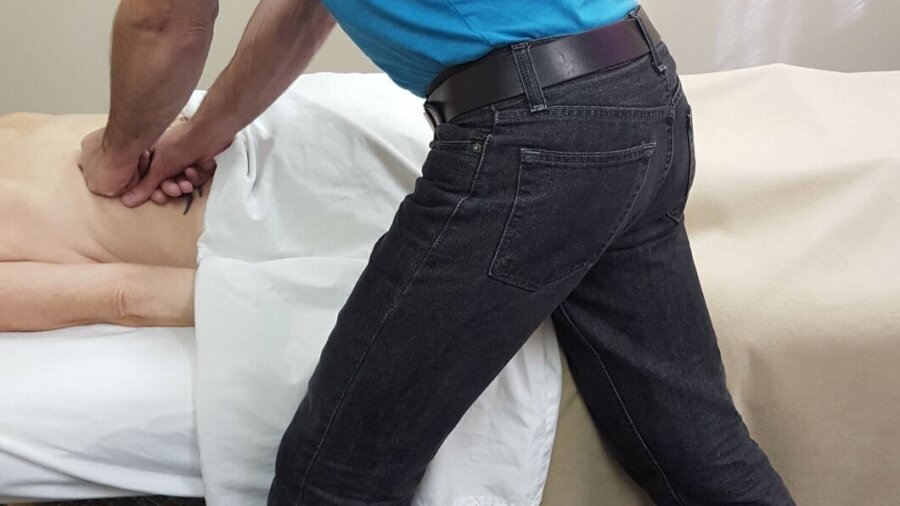


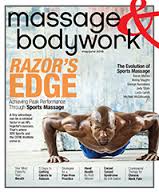


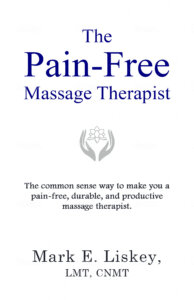
Comments on this entry are closed.